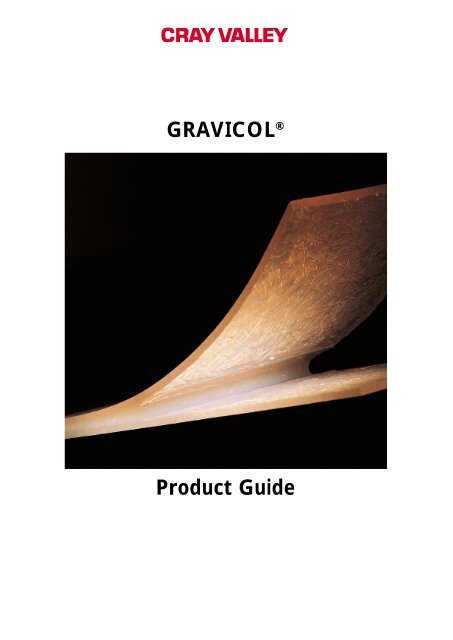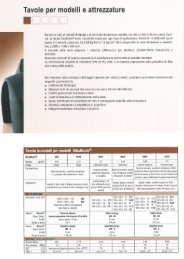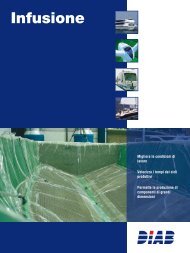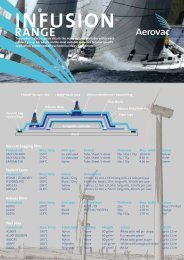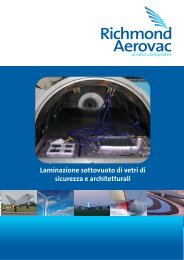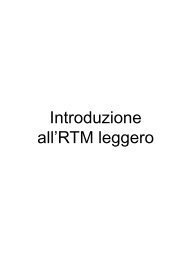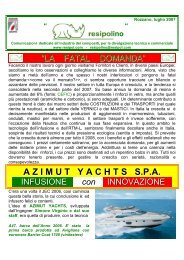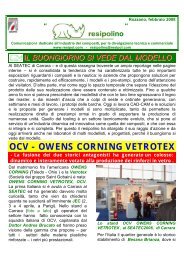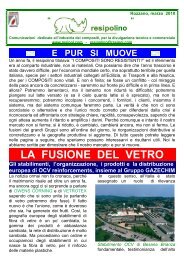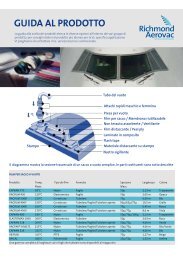GRAVICOL® Product Guide - Resipol
GRAVICOL® Product Guide - Resipol
GRAVICOL® Product Guide - Resipol
Create successful ePaper yourself
Turn your PDF publications into a flip-book with our unique Google optimized e-Paper software.
GRAVICOL ®<br />
<strong>Product</strong> <strong>Guide</strong>
GRAVICOL ® BONDING PASTES<br />
The GRAVICOL ® range of bonding pastes are designed for the assembly and bonding of glass<br />
reinforced plastic moldings.<br />
All of the bonding pastes in the range are pre-accelerated and require only the addition of a<br />
standard MEKP catalyst. The pastes can be used for bonding two parts, insert panels, core materials.<br />
They can also be used for cavity filling and as an aid to lamination to help reduce the chance of air<br />
voids. When designing the bonding pastes there are several key areas we look at and control to<br />
suit the numerous application areas of the pastes :<br />
- Gel/Cure Times - Low Shrinkage Levels - Application Methods - Mechanical Properties<br />
Gel/Cure Times<br />
The products are available with a range of gel/cure times, but are<br />
designed to cure with a low peak exotherm, which assures no<br />
deformation of the parts being bonded.<br />
Low Shrinkage<br />
The low shrink properties of the paste assure that there will be<br />
no ‘pull through’ on the parts bonded. Full bond strength will be<br />
retained as the paste does not pull away from where it is intended<br />
to be, this also allows the bond to form a water/air tight seal.<br />
Application Methods<br />
The physical characteristics of the pastes vary across the range to<br />
suit the different application techniques, which are typically :<br />
-By hand, comb or spatula<br />
-By application equipment which can dispense catalysed material<br />
in a ‘bead’ of adjustable diameter or in a small spray pattern to<br />
cover larger areas more quickly<br />
Mechanical Properties<br />
The different mechanical properties in the range allow you to choose a paste specific to your bond<br />
requirements. Within the range of pastes there are grades with and without glass fibres to suit the<br />
different types of application within the construction of composite parts.<br />
GRAVICOL ® PRODUCTS WITHOUT GLASSFIBRES<br />
For use in thinner joints.<br />
GRAVICOL®<br />
2503 R : A fast, rigid paste with a low level of shrinkage. Suitable for all types of<br />
gluing, filling in and fixing. Economic grade. Available in STD and WHITE.<br />
®<br />
GRAVICOL 2040 : A semi-flexible smooth paste with a low level of shrinkage. This paste has a<br />
longer gel time so it can be used for larger jobs such as fixing core materials or balsa. Available in<br />
TC and IHB TC.<br />
®<br />
GRAVICOL 2039 : A flexible and smooth paste with a low level of shrinkage. It can be used for<br />
bonding, fixing inserts and also as an aid to laminating. Available in TC, IHB TC, WHITE and IHB<br />
WHITE.<br />
GRAVICOL®<br />
3128 : A flexible paste that can be<br />
applied with a spatula, it has excellent adhesion<br />
properties with PVC foams. Available in STD and<br />
IHB.<br />
GRAVICOL®<br />
D 09 : A semi-flexible low density<br />
paste with very low shrinkage. The material can be<br />
applied with a spatula and is used for composites<br />
where final part weight is a consideration.<br />
Available in STD and IHB.<br />
GRAVICOL®<br />
1120 : A semi-flexible, translucent<br />
paste with a fast gel time. Can be applied with a<br />
spatula. Only the STD version is available.<br />
GRAVICOL®<br />
2038 machine : This product has had its viscosity adapted to suit application via a<br />
machine. Only available in the TC version.<br />
ABBREVIATIONS<br />
RANGE OF GRAVICOL ® PRODUCTS<br />
The GRAVICOL ® range of products have been formulated with and without glass fibres. They<br />
are available with a range of properties to suit various applications.<br />
P<br />
STD<br />
Packaging in plastic bag.<br />
Standard material with a typical gel time of about 20 minutes.<br />
GRAVICOL ® PRODUCTS WITH GLASSFIBRES<br />
For use in areas or joints where a thicker application is needed.<br />
GRAVICOL®<br />
2505 : A rigid paste with a short gel time and a controlled level of shrinkage. Used for<br />
application in static bonds. Only the TC variant is available.<br />
GRAVICOL®<br />
2427 : A semi-flexible paste with a low level of shrinkage. Used for filling and bonding<br />
applications. TC and IHB TC versions are available.<br />
GRAVICOL®<br />
2397 : A flexible paste with a low level of shrinkage.<br />
Recommended for use in areas or joints where a thicker application<br />
is required, it can also be used for bonding reinforcements to<br />
substrates. TC and IHB TC versions are available.<br />
GRAVICOL®<br />
2782 : A semi-flexible, translucent paste. Only the<br />
TC version is available.<br />
®<br />
GRAVICOL 3410 : A very fast, semi-flexible paste. Catalysed<br />
with benzyl peroxide. Only the STD cream version is available.<br />
IHB Material with an inhibited gel time.<br />
TC Contains catalyst indicator.<br />
WHITE Contains white pigment paste.<br />
PACKAGING<br />
Standard pastes are available in 25 kg metal pails or 250 Kg drums.<br />
D09 is available in 18 Kg metal pails or 180 Kg drums.<br />
2 CRAY VALLEY<br />
CRAY VALLEY 3
GRAVICOL ® USE AREAS AND APPLICATION<br />
INFORMATION<br />
Making and bonding composites can often be a complex process involving several different parts<br />
and even different material types being involved. In these structures the bond must have the correct<br />
strengths and properties to adhere well with all of the materials used and to cope with the<br />
stresses of the end use of the composite part. A good indicator that a bonding paste has achieved<br />
this is when a failure at a joint is seen within the laminate and not within the bonding paste.<br />
A GOOD BOND<br />
A<br />
good bond depends not only on your choice of bonding paste but also the preparation of and the<br />
geometry of the joint.<br />
The thickness of the joint and the level of stress a joint will have to endure govern the choice<br />
of bonding paste used.<br />
For thicker joints over 5mm glass filled paste is best as the<br />
glass fibres add strength to the bond itself.<br />
For thinner joints less than 5mm a paste with glass fibres<br />
is not needed, just a flexible or semi-flexible paste is<br />
needed, depending on the stress within the joint.<br />
For joints with stress a more flexible grade of paste is<br />
needed like GRAVICOL ® 2427 or GRAVICOL ® 2397 used in<br />
boat market.<br />
For static joints without stress a semi-flexible paste will be<br />
sufficient like GRAVICOL ® 2505<br />
in tank market.<br />
Prepare the<br />
For all bond types our recommendations,<br />
to ensure the best possible adhesion<br />
are to prepare the contact surfaces<br />
with some light abrasion and then<br />
solvent wipe them to ensure that<br />
they are free of all grease, oil and contaminants.<br />
The GRAVICOL ® materials can be applied by either an application machine<br />
or by hand depending on the volume of material being used.<br />
BONDING CORE MATERIALS<br />
Core materials can be bonded onto composite skins to add<br />
strength and insulation to parts whilst retaining lower overall<br />
weights, these materials are usually a foam or balsa material.<br />
The types of paste used for this application are usually without<br />
fibres; the pastes must have low exotherm temperatures and a<br />
low level of shrinkage to ensure that no surface distortion is<br />
caused.<br />
GRAVICOL ® 2039 and 2040 would be most<br />
The pastes suitable for this type of application. For this job<br />
the paste is usually applied with a comb or<br />
must have notched spatula, and obviously the gel time<br />
required depends on the size of the job at<br />
low exotherm<br />
hand.<br />
temperatures To bond PVC foam, GRAVICOL ® 3128 is recommended.<br />
and a low level<br />
of shrinkage<br />
contact<br />
surfaces with<br />
some light<br />
abrasion and<br />
then solvent<br />
wipe them.<br />
Note: Care must be taken when using GRAVICOL ® to bond metals, woods; thermoplastics, parts produced by<br />
RTM and parts made from SMC or BMC to ensure that the parts give a good level of adhesion. Each type of<br />
material must be taken case by case.<br />
GRAVICOL ®<br />
GAP FILLING<br />
The GRAVICOL ® pastes can be used as a gap filler and sealant for certain and<br />
applications. Hard to laminate and intricate areas can have the paste applied<br />
into them before being laminated over or having inserts or core materials placed shrinkage<br />
over them.<br />
properties to<br />
Pastes used for these purposes must have low exotherm and shrinkage<br />
properties to avoid causing distortions in the surface of the laminates. Also the avoid causing<br />
mechanical properties of the paste must be considered to ensure that the paste distortions in<br />
can cope with the types of stresses associated with the bond.<br />
GRAVICOL ® 2039 or 2397 would be suitable for this type of application as their<br />
the surface of<br />
flexibility makes them the laminates.<br />
resilient to stresses<br />
and impacts.<br />
The GRAVICOL ® 2397<br />
is formulated with<br />
glass fibres in it and is<br />
therefore more suitable for heavy gap filling<br />
applications as the glass adds strength to the<br />
bond itself.<br />
GRAVICOL ®<br />
LAMINATING AID<br />
The paste can be used to fill small lips,<br />
edges and detail on parts that are<br />
difficult to laminate. The part can then be<br />
laminated in the normal way either<br />
whilst the paste is still<br />
wet or once it has cured.<br />
The paste then<br />
holds the glass<br />
in place<br />
reducing the<br />
chances of air<br />
voids and<br />
bubbles within<br />
the laminate.<br />
The paste can also be<br />
applied in a thin film<br />
behind the gel coat in<br />
curves and radii, the<br />
fibre glass can then be<br />
pushed into the paste,<br />
the paste then holds<br />
the glass in place<br />
reducing the chances<br />
of air voids and<br />
bubbles within the<br />
laminate.<br />
Low<br />
exotherm<br />
GRAVICOL ® 2039 and<br />
2427 both have low<br />
levels of shrinkage<br />
and low peak exotherm temperatures and are ideal for these applications.<br />
The materials are usually applied in a thin layer, by brush using 1% MEKP.<br />
4 CRAY VALLEY<br />
CRAY VALLEY 5
SUMMARY OF RANGE OF GRAVICOL<br />
BONDING PASTES WITH FIBRES<br />
®<br />
Paste Properties Cured Paste Properties Application Areas<br />
<strong>Product</strong><br />
Appearance<br />
Gel Time/ mins<br />
Catalyst<br />
Bond Development<br />
Time/hrs<br />
Elongation %*<br />
Flexural Strenght/Mpa<br />
Shrinkage %<br />
Bonding<br />
Aid to laminating<br />
Gap filling<br />
Comments<br />
2427 TC<br />
1000 grams of material<br />
Thixotropic Paste 15-23 5 3.9 3,9 34 0.17 0,17 • •<br />
at 23°C using 1% MEKP<br />
Semi-flexible bonding paste for filling<br />
and bonding applications<br />
1000 grams of material<br />
2427 IHB TC Thixotropic Paste 45-65 6 3.9 34 0.11<br />
at 23°C using 1% MEKP<br />
•<br />
Inhibited variant of 2427 TC<br />
1000 grams of material<br />
at 23°C using 1% MEKP<br />
2505 TC Thixotropic Paste 7-11 6 4.1 30 0.31 • •<br />
Semi-rigid bonding paste used for application in static bonds.<br />
Very fast gel time<br />
1000 grams of material<br />
2782 TC Translucent Thixotropic Paste 20-30 5 2.9 20 0.40<br />
at 23°C using 1% MEKP<br />
•<br />
Semi-flexible and translucent bonding paste<br />
1000 grams of material<br />
3410 STD Cream 9310 Cream Thixotropic Paste 6-9 6 3.9 28 0.06<br />
at 23°C using 1% PBO<br />
•<br />
Semi-flexible bonding paste, catalysed with benzyl peroxyde.<br />
Very fast gel time<br />
1000 grams of material<br />
2397 TC P Thixotropic Paste 17-25 at 23°C using 1% MEKP 6 5.4 40 0.25 • •<br />
Flexible bonding paste used for application in dynamic bond<br />
1000 grams of material<br />
2397 IHB TC Thixotropic Paste 40-50 at 23°C using 1% MEKP 10 5.4 40 0.51 •<br />
Inhibited variant of 2397 TCP<br />
*Measured on the base resin<br />
6 CRAY VALLEY<br />
CRAY VALLEY 7
®<br />
SUMMARY OF RANGE OF GRAVICOL BONDING PASTES WITHOUT FIBRES<br />
Paste Properties Cured Paste Properties Application Areas<br />
<strong>Product</strong><br />
Appearance<br />
Gel Time/mins<br />
Catalyst<br />
Bond Development<br />
Time/hrs<br />
Elongation %*<br />
Flexural Strenght/Mpa<br />
Shrinkage %<br />
Bonding<br />
Aid to laminating<br />
Gap filling<br />
Comments<br />
1000 grams of material<br />
at 23°C using 1% MEKP<br />
2039 TC Thixotropic Paste 14-22 6 7.4 35 0.90 • • • Flexible and smooth bonding paste<br />
2039 IHB TC Thixotropic Paste 40-50<br />
1000 grams of material<br />
at 23°C using 1% MEKP 7 7.4 35 1.00 • Inhibited variant of 2039 TC<br />
2039 STD WHITE White Thixotropic Paste 14-22<br />
1000 grams of material<br />
at 23°C using 1% MEKP 6 7.4 35 1.10 • White variant of 2039 STD<br />
2039 IHB WHITE White Thixotropic Paste 40-50<br />
1000 grams of material<br />
at 23°C using 1% MEKP 7 7.4 35 1.30 • White variant of 2039 IHB TC<br />
1000 grams of material<br />
3128 STD Thixotropic Paste 24-36 at 23°C using 1% MEKP 6 7.4 37 1.30 •<br />
Flexible and smooth bonding paste with excellent<br />
adhesion properties with PVC<br />
3128 IHB Thixotropic Paste 40-50<br />
1000 grams of material<br />
at 23°C using 1% MEKP 10 7.4 37 1.50 • Inhibited variant of 3128 STD<br />
2040 TC Thixotropic Paste 60-90<br />
1000 grams of material<br />
at 23°C using 1% MEKP 4 3.7 29 0.35 • Semi-flexible smooth bonding paste used for larger jobs<br />
2040 IHB TC Thixotropic Paste 135-195<br />
1000 grams of material<br />
at 23°C using 1% MEKP 6 3.7 29 0.82 • Inhibited variant of 2040 TC<br />
1000 grams of material<br />
at 23°C using 1% MEKP<br />
2503 R Thixotropic Paste 13-21 6 2.6 25 0.23 • • Rigid bonding paste economic grade<br />
1000 grams of material<br />
2503 R WHITE White Thixotropic Paste 13-21 at 23°C using 1% MEKP 6 2.6 25 0.18 • White variant of 2503 R<br />
Translucent<br />
1000 grams of material<br />
1120 STD 20-30<br />
Thixotropic Paste<br />
at 23°C using 1% MEKP 7 7.4 41 1.70 • Flexible bonding paste translucent<br />
1000 grams of material<br />
at 23°C using 1% MEKP<br />
D09 Thixotropic Paste 9-15 6 3.9 20 0.10 • • Semi-flexible low density bonding paste<br />
1000 grams of material<br />
at 23°C using 1% MEKP<br />
D09 IHB Thixotropic Paste 45-65 7 3.9 20 0.68 • • Inhibited variant of D09<br />
1000 grams of material<br />
2038 MACHINE TC Thixotropic 25-35 at 23°C using 1% MEKP 7 7.4 35 0.15 •<br />
Flexible bonding paste with a viscosity adapted<br />
to suit application via a machine<br />
*Measured on the base resin<br />
8 CRAY VALLEY<br />
CRAY VALLEY 9
STANDARD TEST METHODS FOR GRAVICOL ®<br />
PRODUCTS<br />
B elow are listed a variety of tests we use to check the properties of the bonding pastes :<br />
Gel time : the gel times are tested under controlled conditions 1Kg of material at 23°C using 1% MEKP.<br />
Peak exotherm : a mass of product is prepared and catalysed under controlled conditions and the highest<br />
temperature that mass reaches is recorded as its peak exotherm.<br />
Density : the density of the product is measured; this is of particular importance<br />
to low density grades of GRAVICOL ® .<br />
Mechanical properties : both flexural and compressive strengths of the<br />
GRAVICOL ® pastes are measured.<br />
Shrinkage level : this is measured by casting products into moulds of<br />
known dimensions and then measuring the level of shrinkage away from the<br />
edges of these moulds.<br />
Adhesion, bond development time : this is determined by bonding two<br />
laminates together and then pulling them apart at hourly intervals after<br />
catalysation to determine the time taken to develop full bond strength. This<br />
point is reached when the bond failure is in the laminate and not in the<br />
bonding paste.<br />
Elongation at break : the elongation is measured, again as an indicator to mechanical properties.<br />
HEALTH AND SAFETY<br />
Health and Safety data sheets are available for each grade of bonding paste upon request.<br />
Symbol<br />
R10<br />
R20<br />
Xn Harmful<br />
Flammable<br />
Harmful by inhalation<br />
R36/38 Irritating to eyes and skin<br />
S23<br />
S51<br />
Do not breathe vapour<br />
Use only in well ventilated areas<br />
Storage :<br />
The GRAVICOL ® products should be stored in their original packaging.<br />
The storage temperature should be between 15 and 25°C.<br />
The products should be kept away from all sources of ignition, excessive heat and direct sunlight.<br />
Once a container has been opened it should subsequently be stored in an upright position with<br />
its original lid firmly in place.<br />
Rotate stock, make sure older material is used first; the shelf life of GRAVICOL ® products is 6 months.<br />
STANDARD USAGE RECOMMENDATIONS<br />
The GRAVICOL ® range of bonding pastes is pre-accelerated and<br />
ready to use, requiring only the addition of the appropriate MEKP.<br />
Under normal application conditions (15-25°C), the pastes should be<br />
catalysed between 1.0% (minimum) and 3.0% (maximum).<br />
Personal Protection Recommendations :<br />
When using the material personnel must have the appropriate personal protection equipment :<br />
Safety glasses<br />
Solvent resistant gloves<br />
Overalls<br />
Mix in the catalyst thoroughly.<br />
The surfaces of the parts to be bonded should be free of dust<br />
and contaminants to ensure the best level of adherence.<br />
The surfaces<br />
of the parts<br />
to be bonded<br />
should be free<br />
of dust and<br />
contaminants<br />
to ensure the<br />
best level of<br />
adherence<br />
If necessary the surface of the parts should be<br />
abraded and solvent wiped.<br />
The material can be applied to a part using application equipment, a spatula, a<br />
brush or comb.<br />
The two parts should be pressed together ensuring an even thickness of<br />
glue throughout the bonded part.<br />
Once the bonded part is in place be careful not to move it too soon, as<br />
this may lead to a ruptured or weakened bond. (Ideally the part should<br />
not be moved until it has been left to stand for its full bond development<br />
time.)<br />
Take care, when bonding together parts that utilise an LSE type resin system,<br />
it is usually necessary that these types of parts must have their surfaces<br />
abraded and solvent wiped to allow good bond adhesion.<br />
10 CRAY VALLEY<br />
CRAY VALLEY 11
www.crayvalley.com<br />
La Défense 2 • 12, place de l’Iris<br />
F-92062 - PARIS LA DEFENSE CEDEX FRANCE<br />
Tél. : +33 (0)1 47 96 98 50 • Fax : +33 (0)1 47 96 99 98<br />
CRAY VALLEY Communication • Mars 2005<br />
Industrie à Messages - crédits photos :Serge Rivoallon, Philippe Galard. Photos non contractuelles


